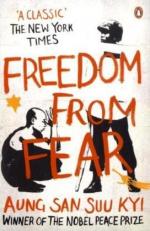
|
| Name: _________________________ | Period: ___________________ |
This test consists of 15 multiple choice questions and 5 short answer questions.
Multiple Choice Questions
1. What form of literature became increasingly popular in Burma near the end of the British rule?
(a) Biographies.
(b) Histories.
(c) Philosophical works.
(d) Short Stories.
2. Who influenced the Burmese in terms of philosophy?
(a) The Indians.
(b) The Persians.
(c) The Chinese.
(d) The Greeks.
3. What was a common theme in Burmese literature near the end of the British rule?
(a) Socialist realism.
(b) Egalitarianism.
(c) The struggle for independence.
(d) The Victorian way of life.
4. Where was the disintegrating effect of the British rule first felt in Burma?
(a) In western Burma.
(b) In lower Burma.
(c) In the Shan Plateau.
(d) In upper Burma.
5. What impact did the British occupation have on the Burmese language groups?
(a) Very little, they remained distinct.
(b) Significant, some of the languages were lost after British occupation.
(c) Many of the languages became Anglified with the introduction of English words and phrases.
(d) Somewhat, some of the languages blended together.
6. When was Aung San assassinated?
(a) Before Aung San Suu Kyi was born.
(b) When Aung San Suu Kyi was sixteen years old.
(c) When Aung San Suu Kyi was ten years old.
(d) When Aung San Suu Kyi was two years old.
7. What was the Burmese approach to life during British occupation?
(a) The Burmese continued their village way of life.
(b) The Burmese developed a network of large towns.
(c) The Burmese developed a feudal system.
(d) The Burmese wanted to industrialize and urbanize.
8. The passage written in 1908 negatively compares the Burmese to the following nationalities EXCEPT?
(a) The Chinaman.
(b) The European.
(c) Indian.
(d) The Siamese.
9. According to Aung San, why did he encourage the Japanese invasion?
(a) Because "already one seems to hear the distant rumblings of another war"
(b) Because "we cannot bank our hopes on possibilities."
(c) Because of "our naive blunders and petit-bourgeois timidity.'"
(d) Because "our people are reeling and suffering unprecedentedly."
10. What comparison does Suu Kyi make to the ongoing national crisis in 1988?
(a) The fallling of The Iron Curtain.
(b) The peasant revolts that have occurred throughout history.
(c) The second struggle for national independence.
(d) The democratic movement in China.
11. According Suu Kyi, who is oppressing the people of Burma?
(a) The military.
(b) The people themselves.
(c) The government's Burma Socialist Programme Party (BSPP).
(d) President Maung.
12. What advice does Aung San give in his inauguration speech?
(a) Do not blame imperialism for their current ills.
(b) To break down the barriers between Burmese people.
(c) If we desire really to know the true economic and financial position in the country, it is not by superficial observations .
(d) To seek a balance between passion and steadfastness.
13. How did the Burmese initially view the Japanese?
(a) As liberators.
(b) As spies for the British.
(c) As oppressors.
(d) As allies.
14. What is the instrument of oppression in totalitarian regimes?
(a) Law.
(b) Punishment.
(c) Power.
(d) Corruption.
15. When was Burma eventually granted its independence by the British?
(a) Six months after Aung San was assassinated.
(b) One year before Aung San was assassinated.
(c) Fourteen years after Aung San was assassinated.
(d) It has not granted Burma its independence.
Short Answer Questions
1. Although the Burmese government refused to acknowledge the document, "The Formation of a People's Committee," the government did which of the following?
2. Why did Burma have few social problems?
3. According to Suu Kyi, what brought the crowd together at the Shwedagon Pagoda in Rangoon on 26 August 1988?
4. According to Aung San Suu Kyi, what was spontaneous?
5. When does law and order gain intrinsic value?
|
This section contains 710 words (approx. 3 pages at 300 words per page) |

|




